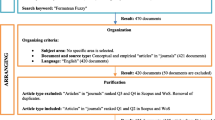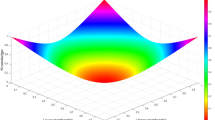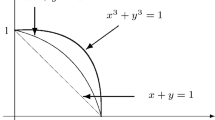Abstract
In the real world there are many linear programming problems where all decision parameters are fuzzy numbers. Several approaches exist which use different ranking functions for solving these problems. Unfortunately when there exist alternative optimal solutions, usually with different fuzzy value of the objective function for these solutions, these methods can not specify a clear approach for choosing a solution. In this paper we propose a method to remove the above shortcoming in solving fuzzy number linear programming problems using the concept of expectation and variance as ranking functions.
Similar content being viewed by others
References
S. M. Bass and H. Kwakernaak,Rating and Ranking of Multiple Aspent Alternative Using Fuzzy Sets, Automatica13 (1977), 47–58.
R. E. Bellman and L. A. Zadeh,Decision Making in a Fuzzy Environment, Management Sci.17 (1970), 141–164.
G. Bortolan and R. Degani,A Review Of Some Methods For Ranking Fuzzy Numbers, Fuzzy Sets and Systems15 (1985), 1–19.
J. J. Buckley,Possibilistic linear programming with triangular fuzzy numbers, Fuzzy Sets and Systems26 (1988), 135–138.
J. J. Buckley,Solving possibilistic linear programming problems, Fuzzy Sets and Systems31 (1989), 329–341.
L. Campos and J. L. Verdegay,Linear programming problems and ranking of fuzzy numbers, Fuzzy Sets and Systems32 (1989), 1–11.
J. M. Cadenas and J. L. Verdegay,Using ranking functions in multiobjective fuzzy linear programming, Fuzzy Sets and Systems111 (2000), 47–53.
S. J. Chen and C. L. Hwang,Fuzzy Multiple Attribute Decision Making, Methods and Applications, Springer, Berline, 1992.
Y. J. Lai and C. L. Hwang,A new approach to some possibilistic linear programming problem, Fuzzy Sets and Systems49 (1992), 121–133.
Y. J. Lai and C. L. Hwang,Fuzzy Mathematical Programming Methods and Applications, Springer-Verlag, 1992.
H. R. Maleki, M. Tata and M. Mashinchi,Linear Programming With Fuzzy Variables, Fuzzy Sets and Systems109 (2000), 21–33.
H. R. Maleki, H. Mishmast N. and M. Mashinchi,Fuzzy Number Linear Programming: A Probabilistic Approach, Nikhil R. Pal and Michio Sugeno, Eds., Advances in Soft Computing AFSS 2002, Proceedings of 2002 AFSS International Conference on Fuzzy Systems, Calcutta, India, Feb. 2002, Springer-Verlag, Berlin, 2002, 491–496.
H. R. Maleki, H. Mishmast N. and M. Mashinchi,Fuzzy Number Linear Programming: A Probabilistic Approach (2), N. Mastorakis and V. Mladenov, Eds., Recent Advances in Computers, Computing and Communications WSEAS 2002, 214–218.
M. Modarres and S. Sadi-Nezhad,Ranking Fuzzy Numbers by Preference Ratio, Fuzzy Sets and Systems118 (2001), 429–436.
M. Roubens,Inequality contraints between fuzzy numbers and their use in mathematical programming, R. Slowinski and J. Teghem, Eds., Stochastic Versus Fuzzy Approachs To Multiobjective Mathematical Programming Under Uncertainty, Kluwer Academic Publishers, 1991, 321–330.
H. Tanaka, T. Okuda and K. Asai,On fuzzy mathematical programming, J. Cybernetic3 (1974), 37–46.
Tong Shaocheng,Interval number and fuzzy number linear programming, Fuzzy Sets and Systems66 (1994), 301–306.
X. Wang and E. Kerre,On the classification and the dependencies of the ordering methods, Da Ruan, Ed., Fuzzy Logic Foundations and Industrial Applications, Kluwer, 1996, 73–90.
E. Yazdani Peraei, H. R. Maleki and M. Mashinchi,A Method For Solving A Fuzzy Linear Programming, J. Appl. Math. & Computing (old:KJCAM) Vol.8 (2001), No. 2, 347–356.
K. P. Yoon,A Probabilistic Approach To Rank Complex Fuzzy Numbers, Fuzzy Sets and Systems80 (1996), 167–176.
H. J. Zimmermann,Optimization in fuzzy environment, Presented at 21th Int. TIMS and 46th ORSA Conference, San Juan, Puerto Rico, 1974.
H. J. Zimmermann,Applications of Fuzzy Sets Theory to Mathematical Programming, Inform. Sci.36 (1985), 29–58.
H. J. Zimmermann,Fuzzy Set Theory and its Applications, Kluwer Academic Publishars, Dordrecht, 3nd edition, 1996.
Author information
Authors and Affiliations
Corresponding author
Additional information
H. R. Maleki received his B.Sc from Shiraz University in Iran, M.Sc and Ph.D (in 1999) both from Shahid Bahonar University of Kerman in Iran. He is Assistant Professor of mathematics in Shahid Bahonar University of Kerman. His research interest is fuzzy operation research and graph theory.
M. Mashinchi received his B.Sc. and M.Sc in Iran from Ferdowsi University and Shiraz University, respectively and his Ph.D in Japan from Waseda University (in 1978). He is Professor of mathematics in Shahid Bahonar University of Kerman. His research interest is in fuzzy mathematics, especially on decision making and algebric systems.
Rights and permissions
About this article
Cite this article
Maleki, H.R., Mashinchi, M. Fuzzy number linear programming: A probabilistic approach (3). JAMC 15, 333–341 (2004). https://doi.org/10.1007/BF02935766
Received:
Revised:
Issue Date:
DOI: https://doi.org/10.1007/BF02935766




